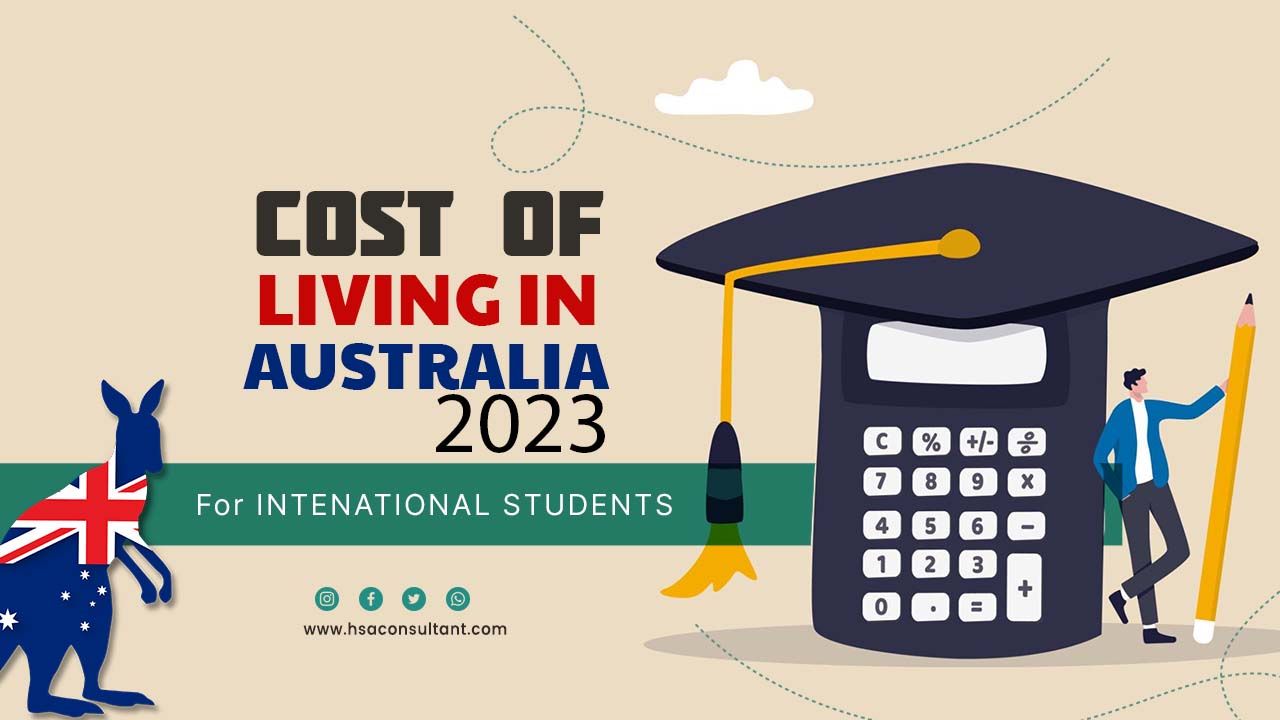Australia is a popular destination for international students pursuing higher education in a diverse and multicultural environment. However, studying in Australia also comes with a significant cost of living that students must plan for and manage wisely. In this blog post, we will provide an overview of the average living expenses in Australia for international students in 2023, as well as some tips on how to save money and budget effectively.
As international students pursue study in Australia, they must clearly understand the different expenses they will encounter. From accommodation expenses to daily necessities and entertainment options, this article aims to shed light on the anticipated average living cost in Australia for international students in 2023, equipping them with essential knowledge and strategies to manage their finances effectively while indulging in everything this country offers.
Average Living Expenses in Australia
According to the Department of Home Affairs, international students need to show evidence of sufficient funds to cover their travel, study and living costs to receive a student visa for Australia. The minimum amount required for a single student is AU$ 21,041 per year, equivalent to about AU$ 1,753 per month. This amount counts as standard living cost, needed in Australia for one year. However, this amount may vary depending on your lifestyle, location, course and accommodation choices. Knowing the average costs of education, housing, groceries, and transportation will help create a budget and manage your finances smartly.
On the study Australia website, they have provided a living cost calculator. By using this option, you can draw an estimate of your approximate average living cost.
| Particulars | Cost (Monthly) |
| Off-Campus Accommodation | AU$ 800 |
| On-Campus Accommodation | AU$ 1,754 |
| Transportation | AU$ 150 |
| Food Cost | AU$ 780 |
| Utility Cost | AU$ 205 |
| Entertainment | AU$ 80 |
| Groceries | AU$ 68 |
| Clothes | AU$ 153 |
| Total Cost of Living with Off-Campus Accommodation | AU$ 2,236 |
| Total Cost of Living with On-Campus Accommodation | AU$ 3,190 |
| Annual Cost of Living | AU$ 26,832 |
The main components of living expenses in Australia are:
The main living expenses in Australia are accommodation, tuition fees, food, transportation, utilities and activities, entertainment, clothing, and health. Australia’s average cost of living ranges between AU$ 2236 to AU$ 3190 per month. The expenses in these components vary according to the circumstances, like living alone will cost more than living in a shared accommodation. Besides basic expenses, your lifestyle defines your average living expenses. We have discussed the costs in the said areas, but these are just potential cost estimations.
Accommodation:
The most significant expense for international students is to manage accommodation, as housing prices in Australia are relatively high compared to other countries. The cost of accommodation depends on the type, location and quality of the place you choose to live in. For example, renting a room in a shared house or apartment can cost between AU$500 and AU$800 per month, while living on campus or in a home stay can cost between AU$700 and AU$1,100 per month. You may also need to pay for utilities, internet and bond (security deposit) when renting a place. You can find more information about the accommodation options and costs for international students on the Study Australia website.
Type of accommodation and their cost:
- On-campus accommodation: AU$ 110-$280 per week
- Shared rental accommodation: AU$ 95-$215 per week
- Rental: AU$ 185-$440 per week
- Home stay: AU$ 235-$325 per week
- Hotels and guest rooms: AU$ 90-$150 per week
Food:
Food costs are a considerable component of your living expenses in Australia. However, the cost of food varies depending on your dietary preferences, cooking habits and shopping choices. The average cost of food for a single student is estimated to be between AU$300 and AU$500 per month. You can save money by cooking at home, buying groceries from local markets or discount stores, and avoiding eating out too often.
Transportation:
Travelling in Australia is relatively easy because of the efficient public transportation system in the country. The cost of transportation depends on the distance and frequency of your travel and the mode of transport you use. Public transport in Australia is reliable and cheap, and use of it can make a difference in your living expenses. Public transportation is more affordable than driving or taking taxis, and you may be eligible for student discounts or concessions on buses, trains, trams or ferries. You can also save money by walking, cycling or carpooling whenever possible. The average cost of transportation for a single student is estimated to be between AU$ 100 and AU$ 200 per month. You can find more information about transportation options and fees in different cities in Australia on the Study Australia website.
Education:
Education costs include tuition fees and other learning materials like textbooks, equipment and stationery. Tuition fees are the amount you pay to your education provider (Australian universities) for your course or program, and they vary depending on the level, duration and provider of your education.
According to Study Australia, the official government site for international students, the typical annual tuition fees or cost of studying in a university in Australia for international students are:
- Undergraduate bachelor’s degree – AU$20,000 (US$13,675) to $45,000 (US$30,769)
- Postgraduate master’s degree – AU$22,000 (US$15,045) to $50,000 (US$34,192)
Besides annual tuition fees, you may also need to pay for other expenses such as application fees, enrolment fees or student services fees. You can learn more about the tuition fees for different courses and institutions on the Study Australia website. Many scholarship options are available to support students financially, who want to study in Australia. The average cost of education for a single student is estimated to be between AU$ 2,000 and AU$ 3,000 per month.
Utilities:
Household expenses fall under this category. Utilities include the cost of electricity, gas, water, internet, phone, and other services. The cost of utilities depends on the size of your accommodation, the number of people you live with, and your usage habits. The average monthly utilities costs around AU$ 200 to AU$ 300 per household. Most housing bills include the cost of utilities, but if not, you must count them in your monthly expenses while planning your budget. By adopting a sustainable lifestyle and mindful consumption of utilities, you can lower your costs for utilities. For example:
- Implementation of energy-saving practices like using daylight instead of light bulbs during daytime
- You are turning off your appliances when they are not in use.
- Use of energy-efficient appliances.
Entertainment:
The cost of entertainment includes leisure activities such as going out with friends, watching movies, visiting museums or parks, joining clubs or societies, or travelling around Australia. The cost of entertainment varies from person to person as it depends on your interests and the affordability of different options in your area. You can reduce your entertainment cost by avoiding luxurious activities and expenses. Instead, you can take advantage of free or low-cost events, attractions and activities offered by your institution, local community or online platforms. The average cost of entertainment for a single student is estimated to be between AU$ 200 and AU$ 400 per month.
- Groceries and eating out: $80 to $280 per week
- Gas and electricity: $35 to $140 per week
- Phone and internet: $20 to $55 per week
- Entertainment: $80 to $150 per week
Health insurance:
As an international student in Australia, you need to have Overseas Student Health Cover (OSHC) for the duration of your visa. OSHC covers some medical expenses you may incur while studying in Australia, like hospital visits, prescription medicines and emergency services. The cost of OSHC depends on the provider you choose and the level of coverage you need. The average annual price of OSHC is around AU$ 500 to AU$ 600 per person.
Other living expenses:
Besides these main expenses, there are some other costs that you should consider when planning to study in Australia.
Visa application fee: Fee you pay to apply for a student visa (subclass 500). The current cost is AU$ 630 per person.
Travel costs: This is the cost of travelling to and from Australia and within Australia during your study period. The cost of travel depends on the distance and frequency of your trips and the mode of transport you use.
Clothing and personal items: This is the cost of buying clothes and other things you need for your personal use, such as toiletries, cosmetics etc. The cost of clothing and personal items depends on your shopping habits and preferences.
Based on these estimates, the average living expenses for a single student in Australia range from AU$ 3,100 to AU$ 5,900 per month. However, these only approximate figures may not reflect your actual situation or needs. Therefore, it is essential to do your research and budgeting before you arrive in Australia.
Tips on How to Save Money and Budget Effectively
Living in Australia can be expensive, but there are also many ways to save money and budget effectively as an international student. Here are some tips that may help you:
Planning: Before you come to Australia, make a realistic budget that covers all your expected income and expenses for each month. You can use online tools such as the Cost of Living Calculator to understand how much it will cost you to live in Australia based on your lifestyle choices. It would help if you also researched the costs of different accommodation options, transportation modes and education providers in your chosen city or region.
Track your spending: Once you arrive in Australia, track your actual spending and compare it with your budget. You can use apps, spreadsheets or notebooks to record and review your income and expenses regularly. It will help you identify where you are overspending or under spending and adjust accordingly.
Save money: There are many ways to save money on your living expenses in Australia, such as:
- Finding affordable accommodation in cheaper areas and suitable locations, sharing housing with other students to cut your cost
- Cooking at home or buying food in bulk
- Saving on utility bills
- Using public transport or alternative modes of travel
- Buying second-hand books, clothes or furniture
- Taking advantage of student discounts, deals or coupons
- Avoiding unnecessary purchases or impulse buying
- Setting aside some money for emergencies or unexpected costs
Earn money: One way to support yourself financially is by earning money. If you have a valid student visa and meet the work conditions, you can work part-time or casually in Australia to supplement your income. However, it would be best not to rely on your work income to cover your living expenses, as it may not be stable or sufficient. You should also balance your work and study commitments and prioritize your academic performance and well-being. You can learn more about international students’ work rights and opportunities on the Home Affairs website.
Conclusion
Living in Australia can be a rewarding experience for international students but requires careful planning and management of your finances. We have provided the details of the expected expenses you will encounter while you study in Australia to help you plan accordingly. Keep in mind that these expenses are mere approximation, and the actual costs may slightly vary depending on the circumstances and your living choices. However, by knowing the average living expenses in Australia and following some tips on saving money and budgeting effectively, you can enjoy your study abroad journey without breaking the bank. For further details and advice, contact HSA consultants.



